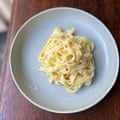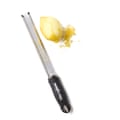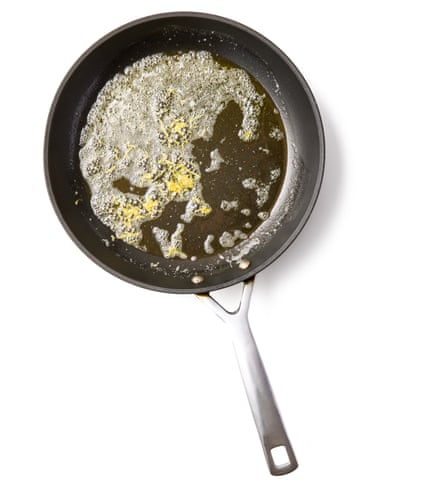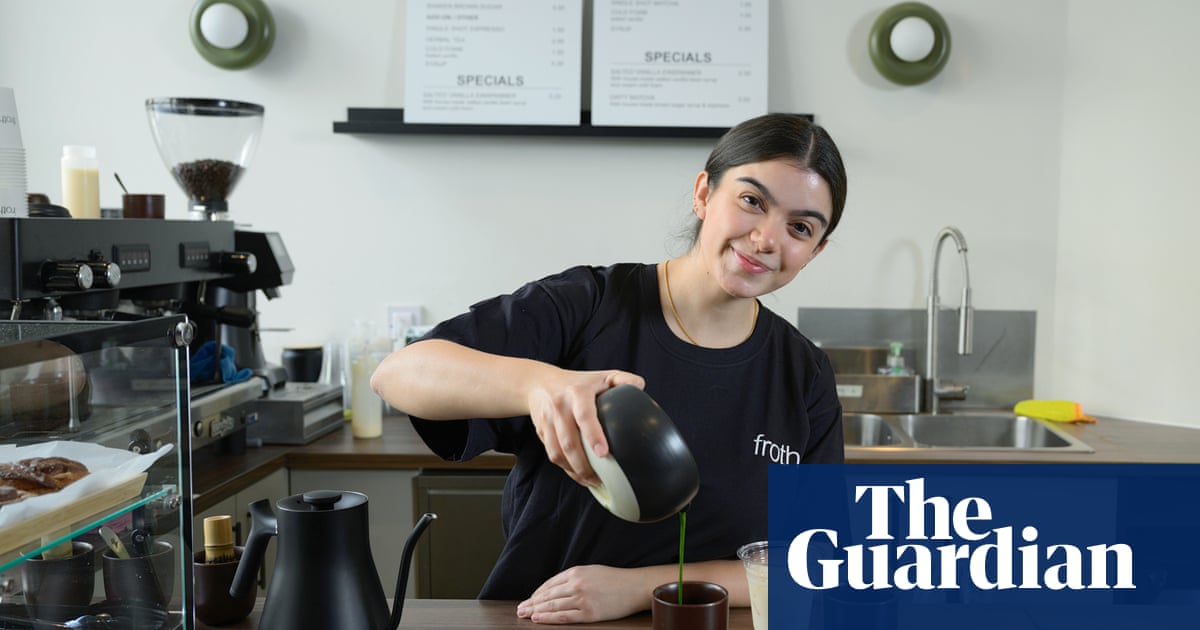Al limone (no translation needed) is perhaps the perfect primo for this time of year, when we’re still waiting for the produce to catch up with the temperatures. The zesty citrus sings of the south, of heavy yellow fruit against a blue Mediterranean sky, while the butter gives just enough richness to make up for any chilly spring breezes. As Nigella observes, this is a dish that can “equally offer summer sprightliness or winter comfort”.
The pasta
Although I happen to agree with Daniel Gritzer when he writes on Serious Eats that “a satiny butter sauce like this pairs better with fresh noodles”, I wouldn’t turn down Catherine Phipps and Nigella Lawson’s dried linguine, nor Rachel Roddy’s dried (or fresh!) tagliatelle in her second book, Two Kitchens, nor even the River Cafe Classic Italian Cookbook’s dried pici. (Pici, Rose Gray and Ruth Rogers explain, “is a handmade pasta, made with plain flour and water, which is only found in Tuscany” – though bucatini, they allow, may be substituted). Though I find spaghetti and linguine the most satisfying to slurp, this selection suggests that just about any long noodle, fresh or dried, is acceptable here. (I note that Ali Slagle uses a short ribbed shape, such as penne or gemelli, in her one-pot pasta with ricotta and lemon for the New York Times, but that seems to me to be a slightly different beast.)
The lemon

Most recipes I try use both the aromatic zest and the zingy juice of the lemon, with Gritzer explaining that “a small dose [of juice] will add a subtle tart counterpoint to all the richness, while allowing the aromatic oils from the lemon zest to remain prominent. More juice will punch up that brightness and also steal some of the spotlight from the zest.” When, as well as how much, you add makes a difference, however; while the oils in the zest, released by grating, can withstand a certain amount of heat, the flavour of lemon juice is much more delicate. So, like Gritzer, I’m going to add it right at the end of cooking – he, Lawson’s How to Eat and Roddy all recommend adjusting the quantity to taste, depending on how punchy you’d like the dish, which seems sensible given that lemons vary so wildly in size, juiciness and acidity (Bee Wilson recently conducted a small survey and found that a rocca imperiale Calabrian lemon yielded twice as much juice as a supermarket version, though it was also four times the price. As a consequence, she writes: “I’m starting to see that there is really no such thing as ‘the juice of a lemon’. There is only the juice of this lemon or of that lemon, each with their own specific perfume, their own pattern of dimples on the skin, their own juice waiting to be discovered under the layer of pith.” She, like the late Russell Norman, favours Amalfi lemons, though you may be relieved to learn I tested this recipe using the common or garden supermarket variety, unwaxed but also ungenerous of juice, and can confirm they will very much do here.)
The River Cafe, whose lemons come from a Tuscan garden, uses just the juice for a more straightforwardly tangy result without the sweeter, more complex perfume of the skin. And while that approach has its merits, it seems a bit of a shame, in a dish that ought to be all about the lemon, to neglect this part of it.
The dairy
This is where the recipes I try diverge, because every recipe I try has a different approach to balancing the sourness of the lemon juice. In Norman’s book Brutto, he calls the “principle of the sauce close to carbonara”, and with a similar egg and grated cheese base. Roddy and the River Cafe’s versions, meanwhile, remind me more of cacio e pepe, in which olive oil, grated cheese and pasta cooking water are beaten together to produce a thick sauce that Roddy describes as “surprising” in that it manages to be “both soothing and vital at the same time”. Both are delicious, but the overwhelming flavour is of cheese, rather than fruit and, while I certainly would never complain about too much cheese, I’d like the lemon to be the dominant flavour note here.

Lawson’s recipe puts me in mind of a less traditionally Italian carbonara-style sauce using egg yolk and double cream, which coats the pasta beautifully and works better, my testers and I decide, than Katie Caldesi’s cream-only version in her (excellent) Italian Cookery Course, which one tester reports reminds them – not unpleasantly, mind – of a “lemon-flavoured yoghurt”. I laugh, but I know what she means: the combination of cream and lemon zest has a tendency, even with Caldesi’s generous hand with the cheese, to suggest possets and the like.
Indeed, Gritzer goes as far as to decree that dairy “mutes lemon flavour”, taming its natural zing into something much quieter and more soothing, which is why he opts for a butter and pasta water emulsion instead. This allows the flavour of the lemon to sing, an approach also favoured by New York chef Frank Prisinzano, who told America’s Test Kitchen in 2023 that the “limone dishes I’ve had on the Amalfi coast are actually made with cream, and I didn’t like it that way. I thought it was too heavy. So I started playing around with making a pasta water and butter emulsion with the spaghetti in the pot. The spaghetti acts as a whisk, and it creates an actual beurre blanc – which is a French sauce – but it beautifully coats the noodles.” (Prisinzano, finding lemon zest “too strong”, simply adds the squeezed lemon shells to the pan to release their aroma, suggesting the presence of a more refined palate than I can boast.)
The cheese
Almost everyone uses parmesan in startling quantities (Caldesi warns readers not to skimp on it, because “the lemon needs the cheese to counteract its sharpness, so scatter liberally”), but I reckon the cleaner, saltier, more acidic flavour of Norman and the River Cafe’s pecorino works much better, if you have some on hand – though I’d guess most hard Italian cheeses would do the job.

Gray and Rogers use two sorts: fresh and aged Tuscan pecorino – the first, a moist, semi-hard cheese, to beat into lemon juice to create a “thick, lumpy sauce”, and the second, drier and more forceful in character, to season and garnish. I won’t be using cheese as the base of my sauce, so I’ve gone for the aged pecorino alone. This has the added benefit of being much easier to find in the UK, but, that said, the flavour of the younger cheese is a lovely pairing with the lemon juice, giving the dish an almost yoghurt-like freshness.
I like the perky flavour and colour that Caldesi, the River Cafe and Norman’s basil brings to the dish (though you may prefer Lawson’s flat-leaf parsley). Roddy reports that she has on occasions also added rocket, while Phipps, in her book Citrus, suggests asparagus, which would be a nice nod to the seasonal produce we have in abundance right now (I suspect that frozen peas, always in season, would also be a good bet).

Gritzer adds garlic, which is gilding the lily; this should be all about the lemon, with a supporting cast of butter, to enrich the sauce and salty cheese to season and thicken it. Simple.
Perfect pasta al limone
Prep 5 min
Cook 10 min
Serves 2 (and easily doubled or halved)

Salt and black pepper
180g-200g fresh thick pasta noodles (or 160-180g dried) – eg, bucatini, spaghetti, fettuccine, tagliatelle or linguine
30g butter
1 unwaxed lemon
20g pecorino romano, or another hard aged cheese, finely grated
1 small handful fresh basil leaves (optional)
Bring a medium pan of salted water to a boil, then add the pasta – it should be covered with, but not swimming in water, because the starchier the water, the better it will be at thickening the sauce later.

While the pasta is cooking, melt the butter in a wide pan until foaming, add most of the grated lemon zest, then turn off the heat until the pasta is ready.
When the pasta is al dente, or done to your liking, scoop out and set aside a small cupful of its cooking water, then drain the pasta well. Turn on the heat under the butter and lemon zest pan to medium-high, then add the drained pasta plus a splash of its cooking water.

Toss vigorously until well coated, then add most of the grated cheese and keep stirring until well combined, adding a little more pasta water if necessary.

Take off the heat, add a pinch each of salt and pepper, the juice of about half the lemon and most of the basil (if you are using it), then toss again to distribute. Taste and adjust as necessary. Divide between plates, top with the remaining lemon zest, cheese and basil, and serve immediately.
-
Cream or butter, pecorino or parmesan? Versions of this fragrant dish are made, the River Cafe claims, from Tuscany to Naples – where does your loyalty lie?

.png) 3 months ago
112
3 months ago
112

















































